Early Holiday Selling = Higher Returns
Q4 Advice from Tinuiti and Cahoot
The holidays aren’t what they used to be – instead, they start sooner and last much, much longer. Did you know that according to the National Retail Federation, 59% of shoppers have made progress on their holiday shopping by early November? And not just a little progress – a full quarter of holiday shopping is already done by then.
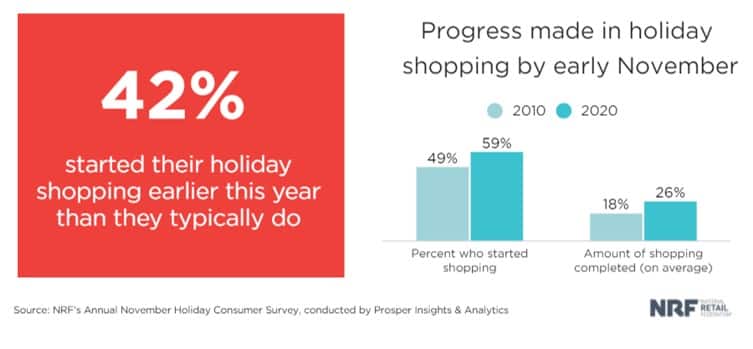
If you’re not ready to sell by early November (or better yet, earlier), you’re missing out on a huge chunk of potential peak sales. And, the trend is only intensifying; customers that shop in December learned the hard way last year that last-minute gift purchases will arrive late, so they’re all moving up their eCommerce buys.
You can’t just turn deals on and expect to win early – more careful planning will net the most profitable returns. Tinuiti and Cahoot teamed up to provide merchants with actionable advice for this holiday season that will help you sell early, often, and at maximum margin. Read on to learn more about how to optimize your advertising and fulfillment strategies this Q4.
Keep Amazon CPC Down
As the holidays ramp up, so does CPC, relates Scott Panno. The higher ad cost goes, the bigger the savings that you earn from efficiency tips, so you’ll want to implement these ASAP.
Target Specific Keyword Phrases
A good rule of thumb is that the more general keyword phrases are more expensive for Amazon CPC. Consider Scott’s example of tools – the phrase “tool organizer” costs $0.85 per click, while the more specific “wrench organizer” costs only $0.73 per click.
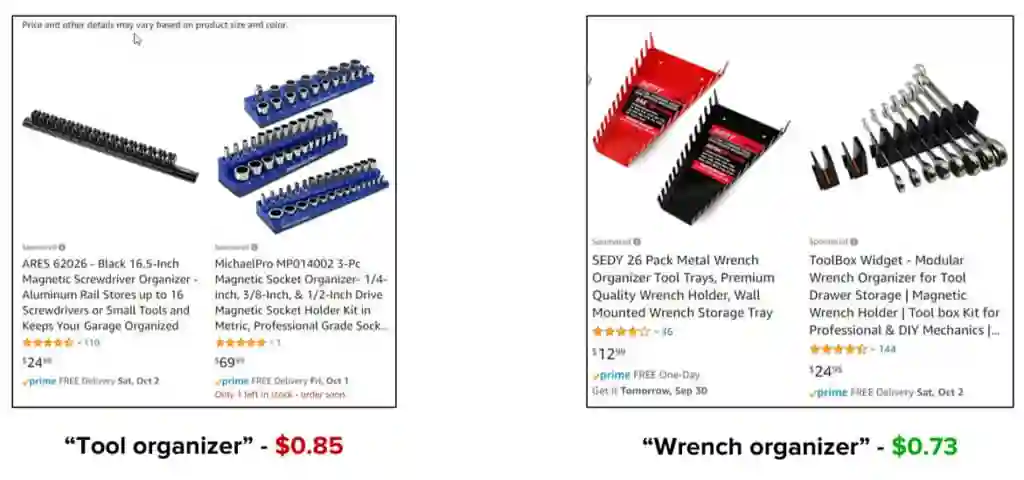
On top of the considerable CPC savings, more specific phrases that more closely match your product will also improve your Amazon conversion rate. Shoppers with specific items in mind that are motivated to purchase will use more detailed keywords, and so once you’ve got their click, you’re more likely to get a sale. The tradeoff is that click volume will likely be lower, but as long as you’re getting enough volume to work through your stock, you’ll be considerably boosting profitability.
Diversify your Amazon Ad Portfolio
We ran a poll during our webinar and found that Amazon sellers aren’t taking advantage of all the ads they can – a big miss during the holiday season when more eyeballs means more sales. In addition, some of the lesser-known ad formats are less competitive and can be more efficient than the Sponsored Display ads that everyone already knows and loves.
Over 50% of our polled audience haven’t yet tried Bottom Headline Ads, and over 40% haven’t yet tried Video ads.
You’re always looking for slight edges over your competition. Here’s one; experiment with the ads that your competitors aren’t using. You’ll be surprised how efficiently they can drive clicks for your products.
Increase Budget on the Biggest Days
This one may sound obvious, but Tinuiti is often surprised by how many of their sellers don’t increase budget for the biggest days of the year. The big holidays have huge volume and lots of sales up for grabs, so don’t have the same small budget that you had two months earlier!
It’s an easy thing to “set and forget” – in Seller Central, you can create a custom advertising rule and detail when to advertise more and how much to increase the budget, and then the system will take care of the rest.
Our advice is to not just focus on the preset date ranges that Amazon provides such as Black Friday. Those are of course great selling days, but we recommend starting to increase your budget in early November or even in October. Holiday shoppers are starting early, so you should, too.
Bigger Images Are Better
Amazon allows bigger images in headline ads, and Scott’s customers have seen fantastic returns from taking advantage of the change.

This new strategy for headline ads doesn’t cost any more than the old way, but it boosts conversion. What’s not to love? You’re all looking for profitable growth, and this is a simple hack to deliver it.
Advanced Amazon CPC Strategies
If you’re already on top of the previous tips we’ve run through, congrats! You’re running a well-oiled machine. We’ll run through a few more less common strategies that can deliver value to even the most seasoned seller.
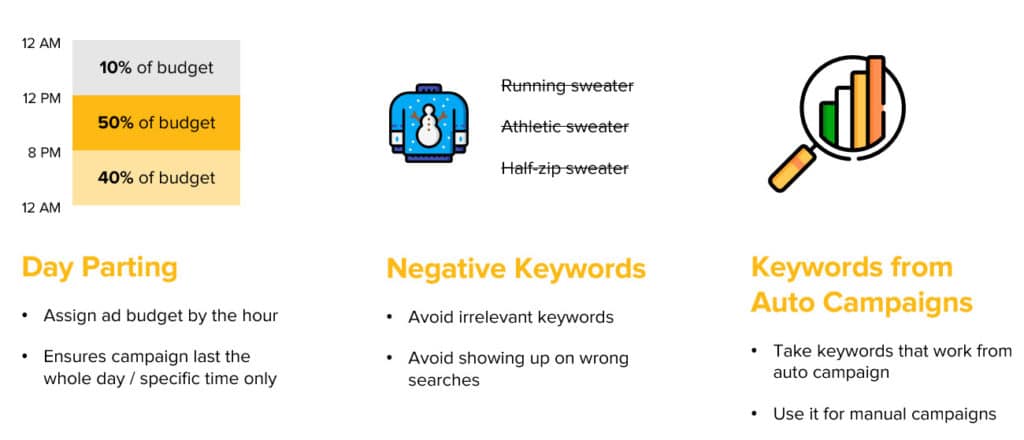
- Day Parting: top sellers understand their buyers intimately, and many will adjust ad budget by the hour to ensure that they’re advertising most when their buyers are online. There’s no one-size-fits-all rule here; you’ll have to test and learn to see what times work best for you.
- Negative Keywords: you can refine your bids with negative keywords to ensure that you avoid irrelevant searches. This takes your bid strategy to the next level by excluding clicks that will never lead to conversions.
- Keywords from Auto Campaigns: learn from auto campaigns! Monitor closely to see what works, and then apply lessons in manual campaigns.
>Improve Amazon Conversion
You can have the most brilliant Amazon CPC strategy in the world, and it will all be wasted if you’re not also optimizing conversion. Scott shared his top tips for sellers to ensure that they’re closing the sale once they have the customer on their pages.
Max Out Secondary Images
You should have seven secondary images for each and every product, which is the maximum allowed. Why? They improve conversion, and moreover, they show up twice in mobile – and mobile shoppers account for >50% of page views during the holidays.
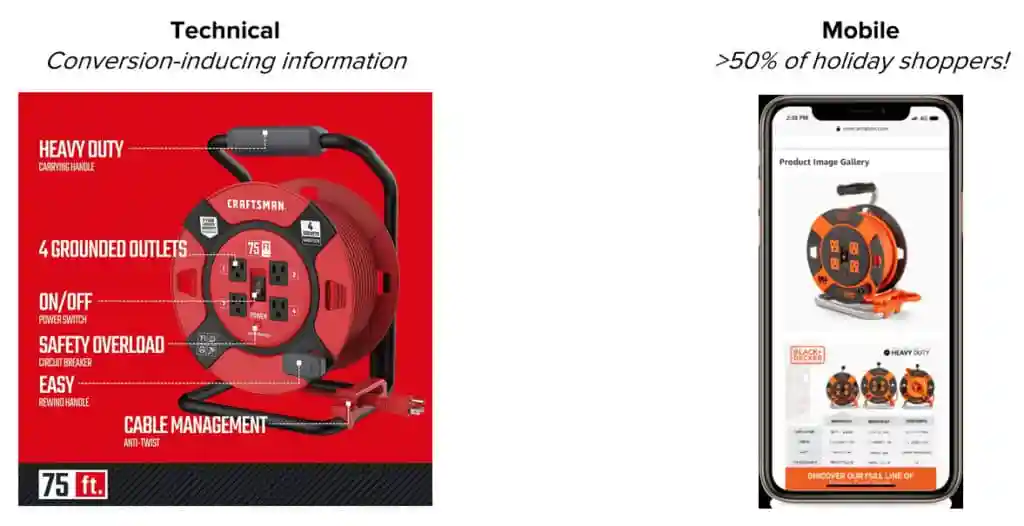
We strongly recommend that you include more technical images, like the one shown above. A picture tells 1,000 words, and these excellent explanations of your product not only increase conversion, but they can also reduce returns by decreasing the number of customers that buy something expecting different functionality.
Posts: Free Advertising!
Many sellers don’t take advantage of Posts at all, which is a big mistake; they’re free!
Posts appear on the product detail page, the posts feed, and the brand feed. They’re a great opportunity to build your brand. Tinuiti recommends that you treat Posts a bit differently from other advertising and imagery, and use them to show people happily using your products. This helps build your product’s story and helps shoppers imagine how it will improve their own lives.
Don’t wait on this one – Posts are relatively new to the game, and Amazon is still heavily experimenting with where and how they show up. We wouldn’t be surprised if they start charging sellers for them in the future, so get in on it while it’s still free.
A/B Test to Max Amazon Conversion
You’ve probably heard this one before, but it bears repeating – you should always have A/B tests running to optimize your pages.
Amazon itself, one of the most successful companies in the world, was built on A/B testing. They continually tweak copy, images, image placement, and more on their site to hone their ability to turn eyeballs into sales, and you should too.
Amazon provides simple yet powerful tools for A/B testing that take out all of the guesswork. If you’re new to A/B testing, we recommend that you start with titles, which is a simple way to get used to the concept. From there, you can go crazy – expand to A+ pages, change images, photo products from different angles, change descriptions, and more. The possibilities to improve your growth and profitability are endless.
Never Stop Bundling
The more listings you have, the more opportunities you have to win. When you see it that way, you’ll instantly understand why bundles are great: it’s a cost-free way to increase your visibility on Amazon and the options consumers have to buy your products.
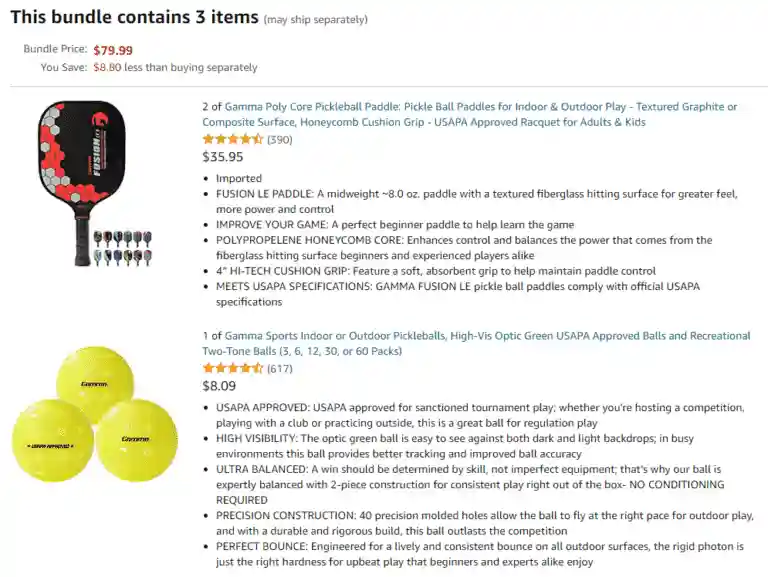
Whether you’re doing it in Vendor Central or Seller Central, the benefits are the same. To further boost your Amazon conversion rate, discount bundles either all the time or strategically while you’re advertising.
While bundling is an excellent tactic across the board, it does have a few limitations. Keep in mind that in Vendor Central, you won’t have metrics, while in Seller Central, you won’t be able to variate. And finally, you can’t cross-bundle between Vendor Central and Seller Central.
>Encourage Early Holiday Shopping
Consumers are shopping earlier than ever, and you can either take advantage of the behavioral shift to maximize Q4 profit, or leave the opportunity and fight in the same old Black Friday rush.
The basic math is simple – selling early isn’t just extra holiday revenue, it’s extra revenue and more profitable. First, your ad dollars will go further because there’s less seller competition, lowering CPC. Next, you’ll also pay less for fulfillment by dodging carrier surcharges and moving product before prices peak across the supply chain.
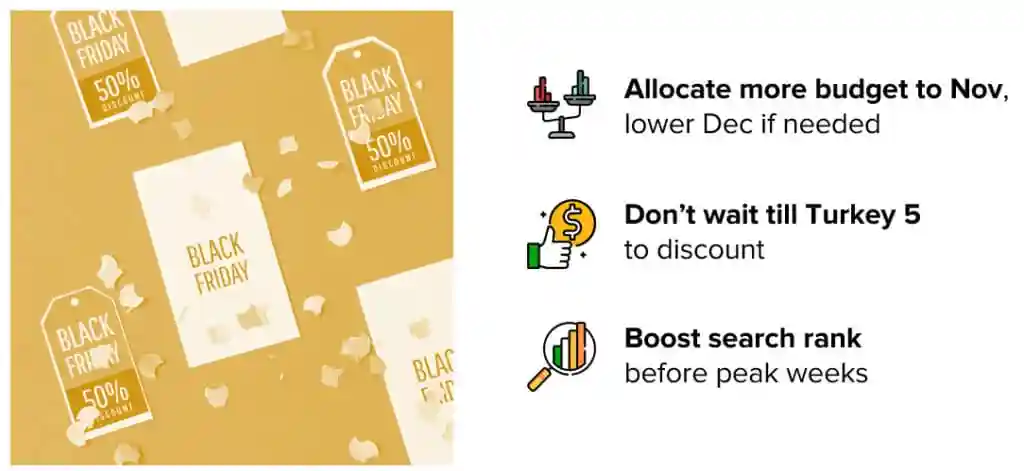
You’ll need to re-wire certain holiday selling truisms to fully benefit from early shopping. Don’t wait to deploy ad dollars; promote early and often to maximize revenue and profit. November is better than December, and October is even now in play for holiday shoppers.
There’s another more hidden benefit to getting out in front of the competition; you’ll have a lead in search rank heading into the peak weeks. Your early investment will thus pay dividends by extending your selling season, boosting your profitability, and also potentially improving your Turkey 5 as well.
Overcome FBA Limits with Amazon FBM
So, you’re convinced – you’re going to sell earlier than ever. But to sell, you of course need inventory ready to go, and Amazon’s limits are squeezing your business and hurting your confidence.
Many, if not most Amazon sellers are in the same boat. Amazon FBA doesn’t have nearly enough space to fit all the products that sellers would like to sell through them, and that won’t be changing any time soon. Consider Amazon’s investment plans, pictured below.

They’ve boosted supply chain CapEx to historically high levels, but they’re still behind and have multiple years of multi-billion-dollar spending on fulfillment capacity to keep up.
To manage this challenge, Amazon FBA has tightened the screws on sellers year after year. They’ve instituted punishing long-term storage fees and increasingly restrictive inventory limits to push out everything but the smallest, fastest-moving SKUs. The Inventory Performance Index (IPI) is the end-all, be-all metric you need to manage to maximize your storage space. We have an entire other webinar all about improving your Amazon FBA inventory limits, but for now, we’ll leave you with the one overriding piece of advice: don’t go out of stock.

Between massive LTL shipping delays, low inventory limits, and Amazon FBA’s own receiving delays, there’s only one reliable way to ensure you don’t have a ruinous stockout this holiday season: Amazon FBM.
Want to learn your options and best practices for Amazon FBA? Read all about alternatives to Amazon FBA in our helpful guide.
Beat the Parcel Carrier Crunch
You’ve heard it all – ships anchored off of ports, carriers trying to hire hundreds of thousands of temporary workers, and of course, the dreaded surcharges. “Shippageddon” is coming – how do you mitigate its negative effects, or better yet, beat it?
Capacity Crunch by the Numbers
We have two simple charts to show you how jammed up the supply chain is. First, take a look at the state of the ports of Los Angeles and Long Beach, the two most critical points in the US supply chain:
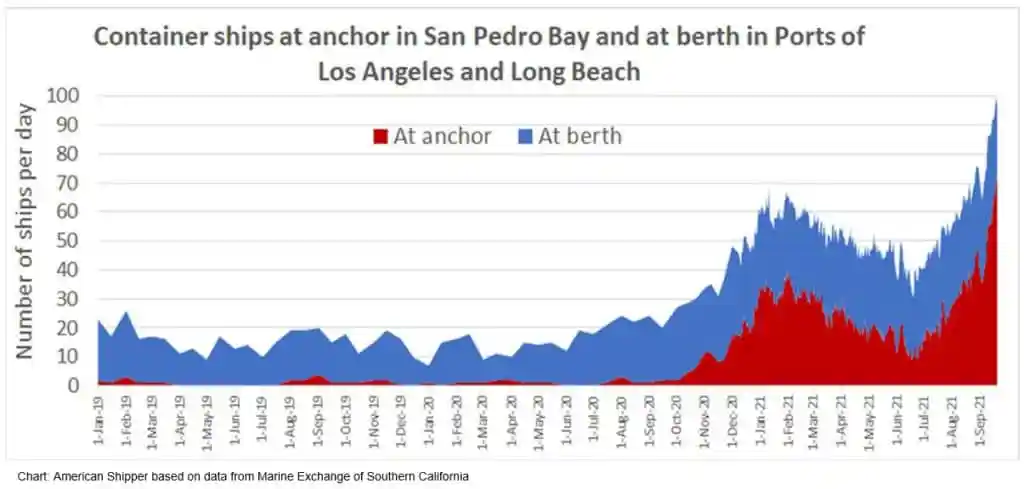
Huge backlogs of product floating off of shore don’t only threaten your ability to get inventory into FBA in time for the holidays; they also unbalance the supply chain and create knock-on challenges for freight. Unfortunately, the trucking world is staring down its own existential issues with the driver shortage.

The net effect of lack of capacity at all points of the supply chain is twofold: 1) your product will be late, and 2) your product will be more expensive to transport.
Quantifying the Cost to eCommerce Merchants
Major carriers take advantage of the rush in holiday demand with surcharges. For instance, FedEx will charge between $1.50 and $3.00 per Ground package from Nov 1 all the way through to Jan 16. USPS is similarly tacking on a variable surcharge based on package size and delivery zone, while UPS is applying surcharges to large items and high-volume shippers.

Any way you cut it, you’ll be paying more this season. But note FedEx’s date ranges. Every sale that you make before Black Friday will cost $1.50 less to get to the customer – how much margin is that for you?
The capacity crunch also negatively impacts your customer experience. Delays are frustrating in normal times, but during the holidays, shoppers are extra sensitive to receiving packages in time for big gifting days. Too bad, then, that December is also the time when the most packages are delayed.
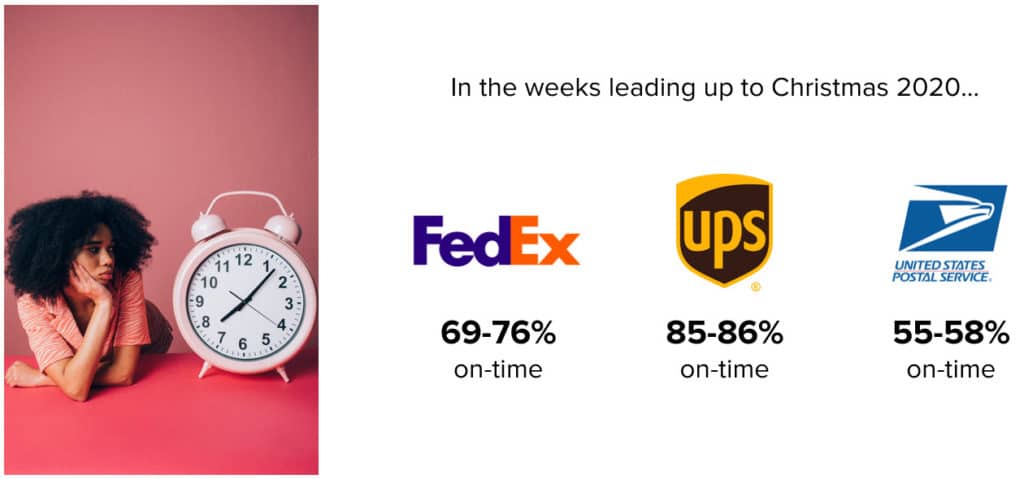
Distributed eCommerce Fulfillment Mitigates Crunch
By selling early, you can avoid the worst of the crunch, but we know that you’re going to start selling early and then sell for the entire holiday season. So how do you fight against supply chain challenges during the thick of Black Friday sales?
Distributed fulfillment answers your needs by unlocking fast and affordable shipping. It’s also less risky by design, as if one area of the country is particularly congested, you always have another region ready to take over.
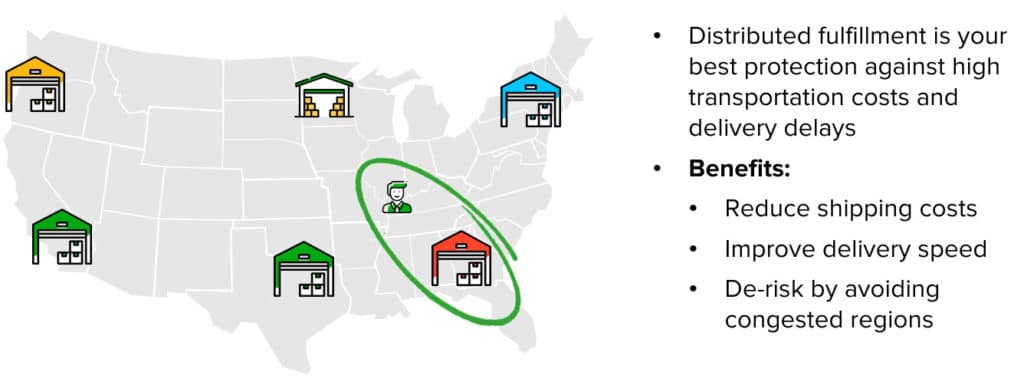
Simply put, distributed fulfillment is an approach that strategically places inventory across the country so that no matter where the customer is, there’s always a fulfillment center nearby. With this strategy, you can always get products to the customer’s doorstep in 1 to 2 days, but you’ll do it with cheap ground shipping rates. This is how FBA offers such low fulfillment fees, but as we’ve detailed above, it’s an incomplete solution at best. You’ll need Amazon FBM to unlock your growth potential for Q4 and beyond.
Cahoot – Your Best Alternative to FBA
A modern and affordable alternative to FBA is to use a peer-to-peer eCommerce order fulfillment network.
A P2P network is a collective of highly vetted eCommerce retailers who offer up excess warehouse space and resources to provide high-quality distributed fulfillment to other merchants. As a result, costs are typically lower than what you get with a traditional 3PL fulfillment company, and service levels are higher. With a P2P network, flexible multi-channel fulfillment with nationwide 1-day and 2-day delivery is the norm. The diverse set of merchants ensures that each customer gets a solution customized to their need, while innovative technology ensures the highest quality fulfillment.
Speaker Bios

Manish Chowdhary, Founder & CEO, Cahoot
Manish Chowdhary is the founder and CEO of Cahoot, the world’s first peer-to-peer order fulfillment network where merchants collaborate to increase their sales and margins by offering profitable one-day and two-day free shipping to customers nationwide. Manish has founded multiple industry-leading companies starting from his dorm room at the University of Bridgeport, CT. Manish’s specialties include e-commerce strategy, business methods innovation, supply chain and logistics optimization, and he holds 10 U.S. patents for his inventions. He has been featured in The New York Times, Forbes, Internet Retailer, and many other leading publications. Manish is a 40 Under 40 Competition Winner and holds an Honorary Doctorate, the highest honor from his alma mater, University of Bridgeport, CT.

Scott Panno, Sr Account manager, Retail Ops, Tinuiti
Scott was a Sr. Marketing Manager at Amazon, working with Vendors in Home, Kitchen, Pets, and Tools to improve content and sales. Post Amazon, Scott has consulted with nearly 100 different companies of all different sizes on Amazon-specific operational and marketing strategy. His vast experience in everything Amazon has helped companies achieve lasting ecommerce success and overall brand growth.
